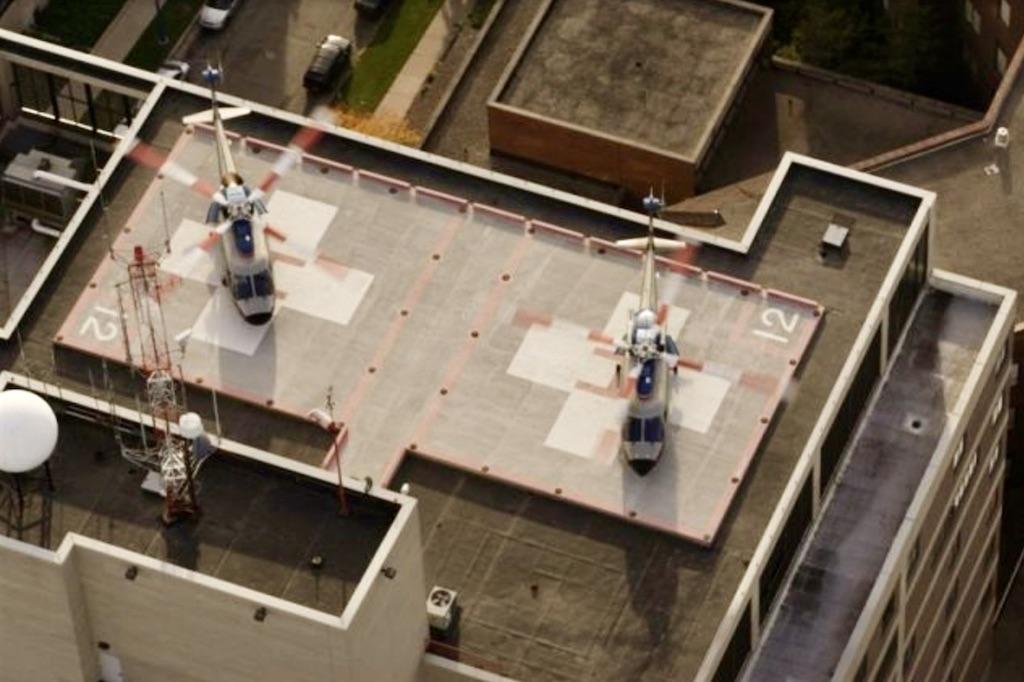High-Profile Crashes A Setback For Urban Helicopter Operations, Part 3

View from above the Spectrum Health Butterworth Hospital helipad before the accident.
Billowing smoke rising from the top of the Spectrum Health Butterworth Hospital Heliport in Grand Rapids, Michigan, on May 29, 2008, sent emergency crews scrambling as news cameras captured the scene.
The NTSB’s thorough investigation in the aftermath provided details of the accident from an aviation perspective. There were no fatalities, but from a fire-fighting perspective, the accident had grave potential to be far worse. The helicopter industry is lucky that the combustible mixture that flowed downward into the hospital did not ignite, or else newspaper headlines the next day would have declared a “towering inferno.” A single spark would have doomed any future utilization of rooftop landing pads.
Before takeoff for a Part 135 checkride, the accident pilots discussed the construction cranes that were operating on the north side of the hospital and their effect on the approach and departure routes to the helipad. Numerous large construction cranes were located within several hundred feet of the 11th-storey helipad.
The three closest cranes were located due west, northwest and north of the platform. They extended fewer than 50 ft. above the helipad. In addition, an elevator penthouse approximately 32 ft. high was located directly to the east with a windsock on a 14-ft. pole, as well as a large, triangular lattice truss-construction antenna, extending about another 40 ft. high, a small Doppler radome and various other small antennae. A television camera was attached about mid-point on the 40-ft. antenna.
The pilot reported that he lifted the Sikorsky S-76A straight up into a vertical takeoff. However, a hospital security video camera showed the helicopter fly backward as it lifted off the helicopter pad. It showed that the tail rotor appeared to strike an object on one of the towers. The tail rotor immediately shattered, and the helicopter went into a right yaw. The pilot attempted to land back on the helicopter pad by using the cyclic and lowering the collective, but the main rotor blades impacted the 32-ft.-high brick structure located east of the helicopter pad.
Based on the NTSB’s analysis of the accident site, the helicopter traveled about a 61-ft. straight-line distance rearward at an angle of about 41-51 deg. relative to the hospital pad. The time from takeoff to impact with the camera was about 11.37 sec. The NTSB determined the probable cause of the accident to be the pilot’s failure to maintain tail rotor obstacle clearance from a tower during takeoff.
A Fire-Fighting Perspective
There are vital events from a fire-fighting perspective that reveal how the accident had every possibility of being far worse.
Medical staff on the top floors of the hospital’s vertical center tower soon noted that aviation fuel was dripping to the 10th floor of the hospital from above. Staff, patients and visitors could see and smell the smoke in the hallways as alarms activated. Multiple failures occurred within seconds of each other. Elevators and communications systems failed, and sprinkler systems burst. The medical staff realized that this was an environment in which a single spark could have caused an explosion.
An emergency evacuation was ordered of the top floors of the hospital’s center tower. About two dozen pregnant women were evacuated in wheelchairs and gurneys, some with IVs attached. Staff rushed to keep vital systems such as respirators functioning despite the intermittent power failure. A newborn infant hooked to a monitor was rolled through connecting buildings. It is a testament to the selfless spirt of the first responders and medical staff who accomplished the emergency evacuation that all of the patients were safely evacuated.
Many innocent lives would have been lost had this combustible fuel mixture exploded. A single spark would have turned this into one of America’s worst aviation disasters in terms of fatalities.
Officials with Spectrum Health subsequently closed utilization of the rooftop helipads until they were enlarged, and enhanced fire-suppression systems were installed for the two pads to complement the original fire-suppression system.
Public Perception Hinders Utilization
Unfortunately, the preceding high-profile accidents reinforce public uneasiness over helicopter operations in urban settings. The vertical-lift industry already faces considerable limitations due to noise, air traffic management, infrastructure and costs that have hindered large-scale utilization of helicopters for alternate modes of transportation in congested metroplexes.
The full benefits from traditional helicopter and electric vertical-takeoff-and-landing operations cannot be realized unless rotorcraft have direct access to congested downtown areas, with landing facilities in proximity to passenger origins and destinations. It only takes a few high-visibility accidents to destroy the public’s trust. Our entire industry’s image and credibility is damaged by these self-inflicted wounds.






Comments